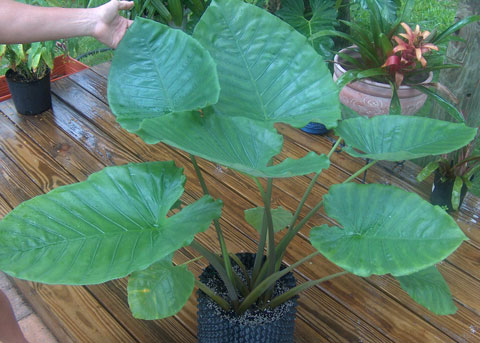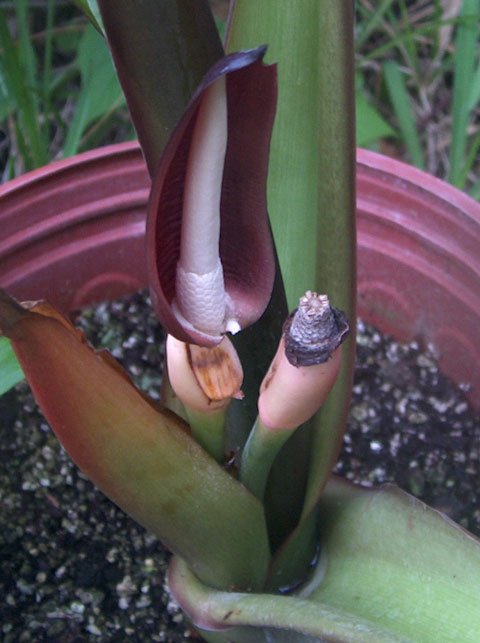Alocasia robusta

2008 Update: See this page for the latest on our hybridization efforts with Alocasia robusta.
This Alocasia is legendary among Alocasia fanciers because of the potential huge size to which it may grow, and because of the difficulty most have in trying to grow it. We, too, have lived through our own horror stories in attempts to keep this plant alive and growing. This year (2007) marks the first time that we have had good success with this plant, and for two reasons. The first can be seen by looking at the peculiar container it is growing in, and the second is that we have been treating these plants with bioprotective microorganisms for the purpose of fending off basal and root rots.
The peculiar container is known as a Superoots Air-Pot, and provides unequalled root aeration when compared to a standard nursery pot. The microorganisms are from commercially available biocontrol products and include Trichoderma sp., Bacillus sp., and Streptomyces sp.
This plant is not the same as the plant known as Alocasia 'Borneo Giant'.
For those who want to try their hand at growing one of these plants, here is some of what we've learned so far. Robustas are, well, robust growers, and that means they will use up their alloted pot space rapidly so long as pathogens stay at bay. We keep ours in one gallon size pots until the plants are more than a foot tall from base to tip of largest leaf, then move to three gallon size pots until the plants are around 3 feet tall. At that point, a move to a 10 gallon pot is appropriate if you are repotting in the Spring. In the air-pots, there is no root circling, so when we unpot them, we see only root tips and small feeder roots. We have found that a combination of two biocontrol products, Companion and Rootshield, provide protection from basal and root rots. We apply one or the other each week, which is more frequently than the label calls for.
Spider mites do enjoy this plant so you need to keep an eye out and eliminate them as soon as you detect them. To avoid using chemical controls, use insecticidal soap as soon as first mites are seen, and also squish as many as you can as some will manage to evade the soap spray. Once a week sprayings may be necessary for a few weeks to get rid of the mites.
One specific nutritional need these plants have is for supplemental iron and/or manganese, at least in the south Florida environment. New leaves tend to come out somewhat chlorotic if this need is not met. We use both chelated iron and chelated manganese, with occasional supplemental magnesium in the form of epsom salts.
Something else to consider is planting a Nephrolepis fern (Boston or Fishtail fern) in with your A. robusta. We are now working on this using three varieties of Nephrolepis ferns; we got the idea from looking at pictures of A. robusta in native habitat, where ferns similar to Nephrolepis ferns are in association with them. We will report further on this as we obtain results.
Nephrolepis fern trial Update - June 21, 2007
We've observed that, in the case of one specimen of A. robusta we moved from 3 gallon to 7 gallon air-pot, with a Nephrolepis variety "Macho Fern" planted in together with it, the overall growth habit of the A. robusta has changed dramatically. While our other A. robusta plants hold their leaf blades from 45 degrees to over 90 degrees away from vertical, the A. robusta with the fern is holding three leaf blades nearly vertical. This makes the plant look more like the ones in some pictures I've seen where the plant is in native habitat with ferns similar to Nephrolepis. Click here to see in pictures what I have described above!
I have already repeated this with other ferns and a few more A. robusta and the results so far have confirmed this observation.
Good Luck!


April 13, 2007 Update!
The first picture above confirms that we have a genuine blooming specimen of Alocasia robusta. This plant was discovered at a good friend's wholesale nursery and he was kind enough to allow us to borrow it for our work. He was unaware that he had a blooming robusta in residence until I brought it to the office! I searched the nursery and this was the only specimen blooming. Curiously, the plant is not as large as one we have at Aroidia Research, but the few leaves show more maturity. Specifically, they are no longer showing any peltate characteristics, while most of the specimens we have still show a degree of peltate characteristic to the leaves. This tells me that the age of the plant, not necessarily the size, is a factor in blooming.
The second picture, taken on April 15 in the early AM, shows male anthesis with pollen drop having already occurred.
May 13, 2007 Update!
As of this date, the only hybridization that has worked using A. robusta pollen is A. odora x A. robusta. This particular cross is the one I most wanted to succeed, as the A. odora is the hardiest of the plants I used in this hybridization series. Berries are swelling rapidly and my hope is that viable seed will be produced. I expect ripening within a month and if viable, seedlings a few weeks after that.
June 13, 2007 Update!
Today the berries have fully ripened so I harvested them and obtained about 25 viable-looking seeds. Their appearance and size suggest hybridity, as selfed seeds of A. odora are larger and smoother. Within a couple of weeks, the morphology of the plantlets should confirm hybridity. Two characteristics I will be watching for is the brownish coloration of the petioles (from A. robusta) and/or the powdery undersides to the leaves (again, from A. robusta). I will report those observations as soon as they are evident.
July 13, 2007 Update!
A check of the A. robusta hybrid seeds reveals that most of them have germinated but the seedlings are still too small to determine specific characteristics. Typically, selfed A. odora seedlings grow rather rapidly, but these seedlings are much slower to start. This observation, in itself, is partial confirmation of hybridity because it is non-typical sprouting seed behavior.
August 13, 2007 Update!

Above you can see how some of the hybrid seedlings look. One of them has a faint bluish look to it and that one is the one I'm keeping a close eye on. Now that they have their first leaves, their growth rate should speed up.
Early April 2008 Update!
To see how the seedlings look now, go to Alocasia x robudora!
| In the Lab | In the Field | The Species | Fruiting | The Hybrids |